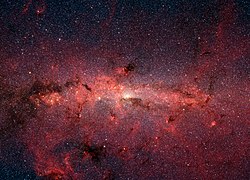આકાશગંગા
Appearance




આકાશગંગા (અંગ્રેજી ભાષા: Milky Way) એટલે આકાશમાં દેખાતી ગંગા. સ્વચ્છ હવામાન હોય ત્યારે રાત્રીના સમય દરમિયાન આકાશમાં જોતાં દુધિયા રંગનો એક ઝાંખો પટ્ટો જોવા મળે છે, જેને આકાશગંગા કહેવામાં આવે છે. આ એક તારાપુંજ છે, જેમાં પૃથ્વી સહિત આખા સૂર્યમંડળનો સમાવેશ થાય છે. આપણી આકાશગંગાનુ બીજું નામ મંદાકિની (દૂધ ગંગા) છે. આપણી આકાશગંગાની સૌથી નજીક આવેલી આકાશગંગા દેવયાની છે. આકાશગંગામાં ૧ અબજ કરતાં પણ વધુ તારાઓ આવેલા છે.[૧][૨][૩][૪][૫][૬]
સંદર્ભો
[ફેરફાર કરો]- ↑ "The Milky Way Galaxy". seds.org. મૂળ સંગ્રહિત માંથી 20 એપ્રિલ 1999 પર સંગ્રહિત. મેળવેલ 5 August 2010.
- ↑ "The Milky Way Galaxy". cass.ucsd.edu. મેળવેલ 5 August 2010.
- ↑ "NASA - Galaxy". nasa.gov. મૂળ માંથી 8 મે 2005 પર સંગ્રહિત. મેળવેલ 5 August 2010.
- ↑ "01.09.2006 - Milky Way Galaxy is warped and vibrating like a drum". berkeley.edu. મેળવેલ 5 August 2010.
- ↑ "How many stars are in the Milky Way?". universetoday.com. મેળવેલ 5 August 2010.
- ↑ "Milky Way, Discover of Milky Way, Milky Way Galaxy at SPACE.com". space.com. મેળવેલ 5 August 2010.
બાહ્ય કડીઓ
[ફેરફાર કરો]વિકિમીડિયા કોમન્સ પર આકાશગંગા સંબંધિત માધ્યમો છે.
| આ વિજ્ઞાન લેખ સ્ટબ છે. તમે તેને વિસ્તૃત કરીને વિકિપીડિયાને મદદ કરી શકો છો. |
